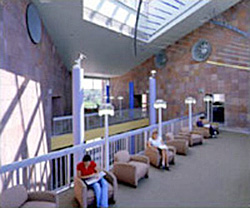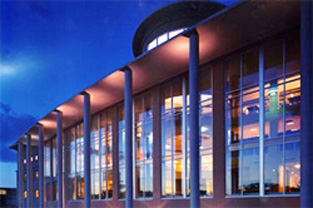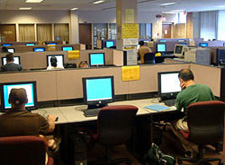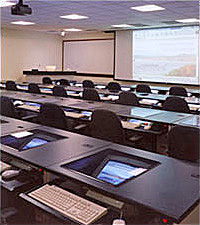Overview
Within This Page
Academic libraries include college and university libraries. Commonly referred to as research libraries, they are often used by students as a quiet place for study and research. In fact, a survey of students at the University of Notre Dame revealed that the majority of students use academic libraries as a place for study, using their own materials. The same user behavior is common to most academic libraries. As a result, when planning academic libraries, it is imperative for the design team to incorporate quiet, comfortable, and adequate space for study. Since academic libraries rely heavily on collections of print material, as opposed, for example, to the large variety of video, audio, and other forms of media commonly found in school libraries, compact shelving to house growing collections is equally an important design consideration as adequate reader seating.


Colorado State University's Morgan Library Addition, Fort Collins, CO
Photo Credit: Perry Dean Rogers Partners Architects
Building Attributes
A. Types of Spaces
There are many broad types of academic library space:
- Collection space
- Electronic workstation space
- Multimedia workstation space
- Viewing rooms and listening rooms
- User seating space
- Staff work space
- Meeting space
- Auditorium or larger lecture space
- Special use space
- Non-assignable space (including mechanical space)
B. Planning Considerations
According to the Association of College and Research Libraries' (ACRL) Standards for College Libraries 2000 Edition, "the library facility should be well planned; it should provide secure and adequate space, conducive to study and research with suitable environmental conditions for its services, personnel, resources, and collections. This library's equipment should be adequate and functional." ACRL provides the following list of questions to answer when developing the academic library program:
- Does the library provide well-planned, secure, and adequate space for users? See also WBDG Functional / Operational—Account for Functional Needs.
- Are building mechanical systems properly designed and maintained to control temperature and humidity at recommended levels?
- What are the perceptions of users regarding the provisions of conducive study spaces, including a sufficient number of seats and varied types of seating? See also WBDG Productive—Design for the Changing Workplace.
- Is there enough space for the library's collections?
- Does the staff have sufficient workspace, and is it configured to promote efficient operations? See also WBDG Productive.
- If there are branch libraries, do they have sufficient space for the collections and staff?
- Is the library's signage adequate? See also WBDG Accessible.
- Does the library provide ergonomic workstations for its users and staff? See also WBDG Secure / Safe—Occupant Safety and Health.
- Are electrical and network wiring sufficient to meet the needs associated with electronic access?
- Does the library meet the accessibility guidelines of the Americans with Disabilities Act? See also WBDG Accessible.
- Are facilities provided to distance learners?
Design Considerations
Design considerations for contemporary academic library space planning are outlined below:

Kent State University provides access to Worldwide Web resources in its libraries as a service to its users.
Photo Credit: Kent State University
-
Modern academic libraries must contain flexible shelving arrangements to house growing collections of research media. It is recommended that floors be designed for 150 pounds per square foot (psf) live loads to allow the arrangement of standard full-height shelving anywhere in the library. Since future growth may require shelving to be relocated, 150 psf design loads will allow the standard full-height shelving to be placed anywhere without being concerned about potential structural damage from excessive point loads caused by overloaded shelves. Increasing the design load to 300 psf allows compact shelving, as opposed to standard shelving, to be placed anywhere. Compact shelving houses a greater quantity of media than standard shelving. See also WBDG Functional / Operational.
-
Movement between adjacent spaces must be fluid. Separations by columns and load-bearing walls must be minimized as they prevent easy future expansion. Since the library's population of media as well as patrons typically increases as the years pass, future growth and expansion should be taken into consideration in the library's design program at the onset of any academic library project. See also WBDG Functional / Operational-Account for Functional Needs, Productive-Design for the Changing Workplace, Accessible—Beyond Accessibility to Universal Design.
-
Fourteen to 15-foot ceiling heights are recommended to accommodate large ductwork. Low-voltage telephone and data distribution systems are often arranged in open visible troffers and coves so that the library space can be easily arranged at a later time without the concern of relocating communications connections. See also WBDG Productive—Integrate Technological Tools.
-
User needs require that academic libraries continually update its collections. As collections grow, storage/shelving space decreases. As a result, compact shelving must be included in any academic library. Storage of periodicals or government documents in compact shelving has become common practice.
-
Adequate space for information and media systems should be included in the library program. Most building programs now include information systems, instructional space, media storage, production facilities, and often the campus' computer services. See also WBDG Productive—Accommodate Technological Tools.
-
Technology has demanded new kinds of space needs. Computer workstations with adequate space for a librarian's assistance are essential and require added floor space. Electronic information kiosks located near library entrances require floor space not taken into consideration during the days before the emergence of computer technology. In addition, user needs now demand adequate space for group study, interlibrary loan centers, and seminar rooms, among others. See also WBDG Functional / Operational—Account for Functional Needs.
-
The space needs for workstations mimic that required to accommodate office workstations at 30 to 35 square feet for each reader. Although computers are commonly placed in any academic library design, space for backpacks, notebooks, and hardcopy research materials is still essential. See also WBDG Productive.

Computer classroom at Marist College's James A. Cannavino Library, Poughkeepsie, NY
Photo Credit: Perry Dean Rogers Partners Architects
Emerging Issues
In addition to the emerging issues of sustainable design and wiring technology to accommodate modern communications (see Public Libraries: Emerging Issues), digital media, and the space required to accommodate it, is experiencing rapid growth. Digital media resources come in many forms including Internet delivery and satellite technology. Some of the program considerations for media resources in academic libraries as noted in the Association of College and Research Libraries' "Guidelines for Media Resources in Academic Libraries" are as follows:
-
The media resources program should provide adequate space for housing collections and for use of the materials. Media space design should consider the rapidly evolving world of digital media and the attendant networking requirements. Magnetic materials and optical storage media required specialized storage for conservation and preservation. Archival collections should receive special treatment and handling.
-
Media resources should be available in a variety of playback situations, including a mixture of individual, small group, and large group viewing facilities.
-
Archival media resources collections require specialized storage and handling. The library should establish a program for archiving media resources, even if housed in a separate special collection. Some media resources may need to address long-term environmental impacts from humidity and temperature.
Increasingly, academic curricula are based on collaborative and group projects. As a result, there is less and less emphasis on traditional, individual study settings, such as long rows of individual study carrels. Instead, academic libraries are developing learning centers, which provide group study rooms and settings, well-supported by access to electronic information resources, hardware tools, and associated productivity software. See also WBDG Productive—Design for the Changing Workplace and Productive—Integrate Technological Tools for flexible design concepts, which are applicable to academic libraries.
Some academic libraries are also implementing wireless communications technologies to allow library staff members to roam through the stacks and reader seating, without being bound to a reference desk, the better to provide support to patrons at the point of contact.
Relevant Codes and Standards
Model Building Codes that may apply include the following (check with local building departments for code requirements):
Note: Some states have their own state-written building codes. In addition, some localities have their own local codes. State and local building departments are the best resource for applicable codes.
- Americans with Disabilities Act (ADA)
- American with Disabilities Act Accessibility Guidelines (ADAAG)
- Architectural Barriers Act (ABA)
Also note that the American Library Association, Building and Equipment Section has published a guide to recommended space allocations for furnishings, equipment, and resources to be housed in the library:
- Building Blocks for Planning Functional Library Space 3rd Edition, Scarecrow Press, 2011.
Additional Resources
Associations
Publications
- Academic Libraries as High-Tech Gateways: A Guide to Design & Space Decisions, 2nd ed. by Richard J. Bazillion and Connie Braun. Chicago, IL: American Library Association, 2000.
- Building a Scholarly Communications Center: Modeling the Rutgers Experience by Boyd Collins, et al. Chicago, IL: American Library Association, 1999.
- Planning Academic and Research Library Buildings, 3rd ed. by Philip D. Leighton and David C. Weber. Chicago, IL: American Library Association, 1999.
- Planning Additions to Academic Library Buildings: A Seamless Approach by Pat Hawthorne and Ron G. Martin, eds. Chicago, IL: American Library Association, 1995.








